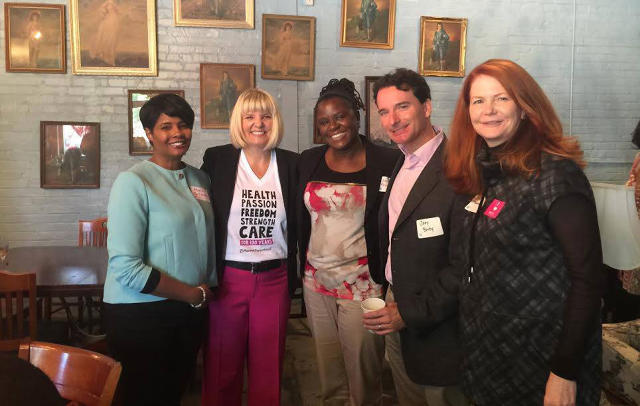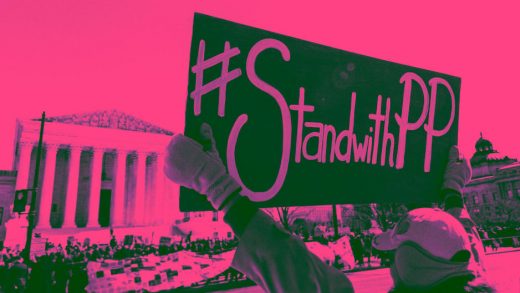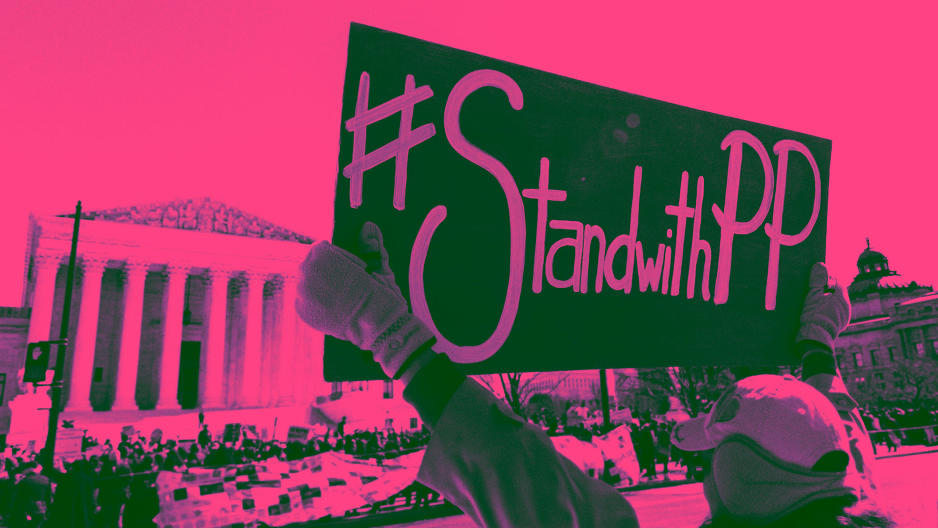This Is How Planned Parenthood Is Gearing Up For Its Hardest Fight Yet
When Sarah Stoesz became the CEO of Planned Parenthood Minnesota, North Dakota, South Dakota 15 years ago, her affiliate included 29 clinics. Today, there are 19. A barrage of state laws restricting abortion access, funding cuts, and anti-choice policies have caused clinic after clinic to close, leaving large swaths of the region without access to quality reproductive health care.
Despite the fact that a majority of Americans supports reproductive rights; despite a weight of evidence proving that accessible family planning services leads to healthier, more economically vibrant communities; despite the mountain of barriers that low-income women, young women, and women of color face in accessing health care, conservative legislators have pledged to “defund” Planned Parenthood. It is a crusade for Stoesz, and all the leadership of Planned Parenthood is ready to fight.
“The values that Planned Parenthood represents are in fundamental disagreement with the values of many of the people who have now been elected to Congress and to legislatures across this country,” Stoesz says. “We are not planning on losing this fight. How to prevent this is the first thing I think about every morning and the last thing I think about before going to sleep.”
What The Fight to “Defund” Really Means
In 2015, Planned Parenthood received $553.7 million in funding from government health service grants and reimbursements, constituting around 40% of its annual budget. The term “defunding” has emerged as shorthand to encompass the many ways that Congress can cut off this support. At the moment, Republicans are targeting Planned Parenthood’s ability to receive Medicaid reimbursement, which accounts for 75% of the government support Planned Parenthood receives.

This money is not bequeathed to Planned Parenthood in one large chunk. The organization operates 650 health clinics around the country that accept Medicaid in order to provide essential health care—STI testing and treatment, cancer screenings, pap smears, contraception, and more—to low-income patients. After Planned Parenthood provides these services, clinics submit a claim to Medicaid for reimbursement—just like any health care provider that accepts Medicaid. This does not include abortion services because the Hyde Amendment has prohibited federal funding for paying for abortion care since 1976.
The vast majority (79%) of Planned Parenthood health care patients have incomes at or below the federal poverty level, and Planned Parenthood is often the only place they can go. Without convenient and affordable access to reproductive health services and family planning, unplanned pregnancies go up. Maternal and infant mortality rates go up. Incidences of unsafe and self-induced abortions go up. STI rates go up. The impact of losing this care would be drastic.
A 100-Year Fight
For any organization fighting for survival—whether it’s an international nonprofit or a scrappy tech startup—chaos and anxiety can run rampant. Leaders are not only responsible for keeping their organizations afloat, but must also reassure employees, stakeholders, and clients that everything is going to be okay. This is a steep challenge, but coping with resistance is part of Planned Parenthood’s DNA. Ten days after Margaret Sanger opened the U.S.’s first family planning clinic in Brooklyn in 1916, she and her colleagues were arrested.
“The intent here is to destroy Planned Parenthood, not just because we do particular services, but because we are a champion of one of the most radical ideas in history—that a woman’s body is her own,” says Dawn Laguens, Planned Parenthood’s executive vice president. “That was a radical idea 100 years ago and apparently is still a radical idea. We’ve been through ups and downs and we are not going anywhere. We will use every means possible or necessary to protect that care.”
Related: In Pictures: 100 Years Of Design At Planned Parenthood

Planned Parenthood’s leaders, particularly those working in primarily conservative parts of the country, are accustomed to fending off political attacks. Staci Fox—the president and CEO of Planned Parenthood Southeast (PPSE), which covers Georgia, Alabama, and Mississippi—said that the Trump-Pence administration’s threats are nothing she hasn’t seen and fought before. Her affiliate has successfully fought similar defunding measures in Alabama and Mississippi over the past two years. When Alabama Governor Robert Bentley announced in 2015 that he was terminating the state’s agreement to provide Medicaid reimbursements to Planned Parenthood, PPSE filed a lawsuit challenging the decision and won.
“We’ve been living and breathing these battles in the South for decades,” Fox said.
Lawsuits have proved a powerful and effective defensive strategy for Planned Parenthood, with courts around the country and at multiple levels of government affirming that defunding violates the Medicaid Act. Twenty-four states have attempted to cut off Planned Parenthood funding over the past few years, and Planned Parenthood has overwhelmingly won lawsuits challenging these measures in Mississippi, Louisiana, Kansas, Arkansas, Ohio, Arizona, Indiana, Utah, Florida, and Texas (to name a few). Its own legal team, along with organizations like the Center for Reproductive Rights and the ACLU, have pledged to fight defunding and other anti-choice measures in the courts every step of the way.

While operating under duress is not new for Planned Parenthood, there is no doubt that this moment—with a White House, Congress, and cabinet stacked against it—is particularly worrisome. The organization’s mission is not just to provide comprehensive reproductive health care, but also to serve patients regardless of their ability to pay. Stoesz said that even without government funding, Planned Parenthood will never close all its doors, but blocking Medicaid reimbursements undermines the “access for all” pillar of its mission.
“We have never faced this kind of threat before, but at the same time, the outpouring of support for Planned Parenthood is unlike anything I’ve seen before,” Stoesz said. “It’s the worst of times, it’s the best of times. It’s also an unmapped time. We are planning our own strategic moves, but because there is so much uncertainty, it’s harder than normal to plan strategy.”
Hitting The Streets
Regardless of what’s happening in politics, Planned Parenthood has always made mobilizing grassroots support a strategic priority. Now, in the face of overwhelming political opposition, this support is more critical than ever. Planned Parenthood is working to harness the post-election/inauguration energy and outrage into political activism—calling on supporters to participate in rallies and protests, make donations, sign petitions, canvas in communities, call politicians, and volunteer. The leadership wants to send a clear and unavoidable message to politicians that Planned Parenthood has a powerful movement behind it.

“First and foremost, we are mobilizing our supporters,” Fox says. “One in five women in this country, at some point in their life, will have been to a Planned Parenthood. That’s a lot of women. Whether here in Atlanta or D.C. or California, people are hitting the streets. We are trying to give people voices to make sure they are heard so folks know this type of legislative move in Congress is not the will of the people.”
For example, on January 6, Planned Parenthood supporters showed up at Speaker Paul Ryan’s office to deliver 87,000 petitions. Planned Parenthood was also a partner for the Women’s Marches that attracted millions of people across the country after Inauguration Day. However, the question remains whether grassroots activism will be enough to prevent defunding. In any case, the wave of public support has heartened Planned Parenthood leaders and employees who said they feel more resolved than ever to keep fighting.
Related: What Will It Take For The Women’s March To Become A Movement?
“I am so energized right now, and I think our staff are too,” says Stoesz. “Among the 350 people that work here, I hear them saying to each other, ‘We got this, this is what we do, this is what we were born to do.’ We’ve been building our muscle for this fight for 100 years and practicing our moves.”

Even the most determined optimism is not enough to keep creeping anxieties and fears at bay. According to a clinic worker at Planned Parenthood of NYC, who wished to remain unnamed, “the vibe is defiant but anxious.” Optimism and resolve is tempered by realism, although the specifics of what will happen if Planned Parenthood is defunded remain unclear.
“We always have contingency plans, but I am so far away from conceding that will be necessary that I’m not ready to do much of that work.” says Stoesz. “No matter what happens, we are not closing down Planned Parenthood. In the worst case, we will be engaged in thinking more and more creatively about how to pivot so that we can continue to be Planned Parenthood in whatever political environment we find ourselves.”
Without federal funding, Planned Parenthood would have to adapt. It would have to seek out other ways to serve low-income patients and support clinics in underserved areas. This prospect is neither simple nor easy. According to a Congressional Budget Office report, defunding Planned Parenthood would greatly reduce access to services for up to 630,000 people (resulting in thousands of unplanned births). This estimate does not account for the people who would lose care if defunding caused clinics to close. Some Medicaid patients would choose to pay for Planned Parenthood services out of pocket. Others would forego care altogether.
“If Planned Parenthood is defunded, it is going to cause a public health disaster,” says Laguens. “We are doing a lot of thinking and meeting and trying to figure out how, in the short term, we could fill gaps or find other places for people to go. But the reality is that there is just no way if people are denied coverage, we are going to be able to make that up or find ways for them to be served.”

Politicians pushing defunding have claimed there are other places Planned Parenthood patients can go for these services, such as Federally Qualified Health Centers (FQHCs). But many of the FQHCs and rural health clinics they tout are not required to provide family planning services or are not required to serve low-income patients. Among the limited number of health centers that are equipped to provide reproductive health care and accept Medicaid, many are already burdened with waiting lists and long lines. They would not be able to handle the upsurge in patient volume. There are no good backup plans, which Laguens said is driving Planned Parenthood to brainstorm new ways to deliver its services.
“We are focused on two fronts: Fighting for service to be provided in-person, and continuing to push boundaries of all the other ways we can get care to people,” says Laguens. “We are thinking about innovations that can open up the next frontier. I still don’t see how we will do an IUD by drone, but hey, if we can, we will figure that out.”
Planned Parenthood can and will survive without government funding. Losing Medicaid reimbursement would be a major blow, but not a fatal one. Rather than legislating the organization out of existence, the only thing lawmakers will accomplish with defunding is to deny poor people access to care. Planned Parenthood’s leaders say it has been around for 100 years and will be around for 100 more. The organization will find a way to survive, but in the meantime, millions of women will find themselves bereft of options.
Fast Company , Read Full Story
(42)



